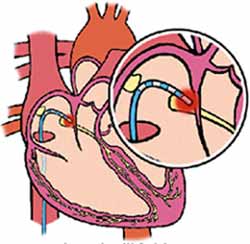Ablation
Electromagnetic energy is used in medicine in “ablation” procedures for maladies such as atrial fibrillation. This is the irregular beating of the upper chambers of the heart, or atria, caused by irregularities in the electrical signals that the heart produces, which cause it to beat. Over two million people around the world are diagnosed with atrial fibrillation every year.
Atrial fibrillation occurs because of the failure of the heart’s natural pacemaker, called the sinoatrial node, to send out smooth, regular pulses. When it fails, rapid, irregular pulses are emitted from various points in the hearts upper chambers, or atria. The atria begin to beat rapidly but weakly, a condition called fibrillation. The fibrillation may stop on its own, only to return again later. In some cases, patients may die because of the fibrillation. To put a stop to this condition, doctors must access the inside of the heart and determine where the irregular electrical pulses are coming from. Usually, these places can be pinpointed with great precision. Then the doctors face the problem of what to do about them. One treatment is called “ablation,” which involves killing a small bit of heart muscle near point or points where the irregular pulses originate. This stops the irregular pulses, allowing the sinoatrial node to operate normally.
In the earliest ablation procedures developed around 1982, the surgeon inserted a long metallic probe into an artery and threaded it into the heart’s upper chambers. Then, direct-current electricity was conducted down the length of the probe and the tip touched to the malfunctioning points of the heart, where it killed tiny areas of muscle.
Once killed by ablation, heart cells then cease to conduct electricity and therefore they do not allow the heart’s electrical signals to become misdirected. However, this “direct current” ablation sometimes caused unwanted side effects such as internal bleeding, so doctors then began using radio-frequency energy, which avoided those side effects. The success rate for ablation procedures rose from only 65% for direct current to as high as 95% with radio frequency. More recently, microwave and laser energy has been used for this purpose, since microwave probes produce slightly larger wounds in the heart. Although this sounds dangerous, actually it is a more reliable treatment. Since that time, microwave ablation has become the most popular surgical approach to the problem of atrial fibrillation (there are also drug and pacemaker therapies). Ablation procedures are also used on other parts of the body; for example, a popular use of medical lasers is ablation of the skin to reduce vericose veins.
